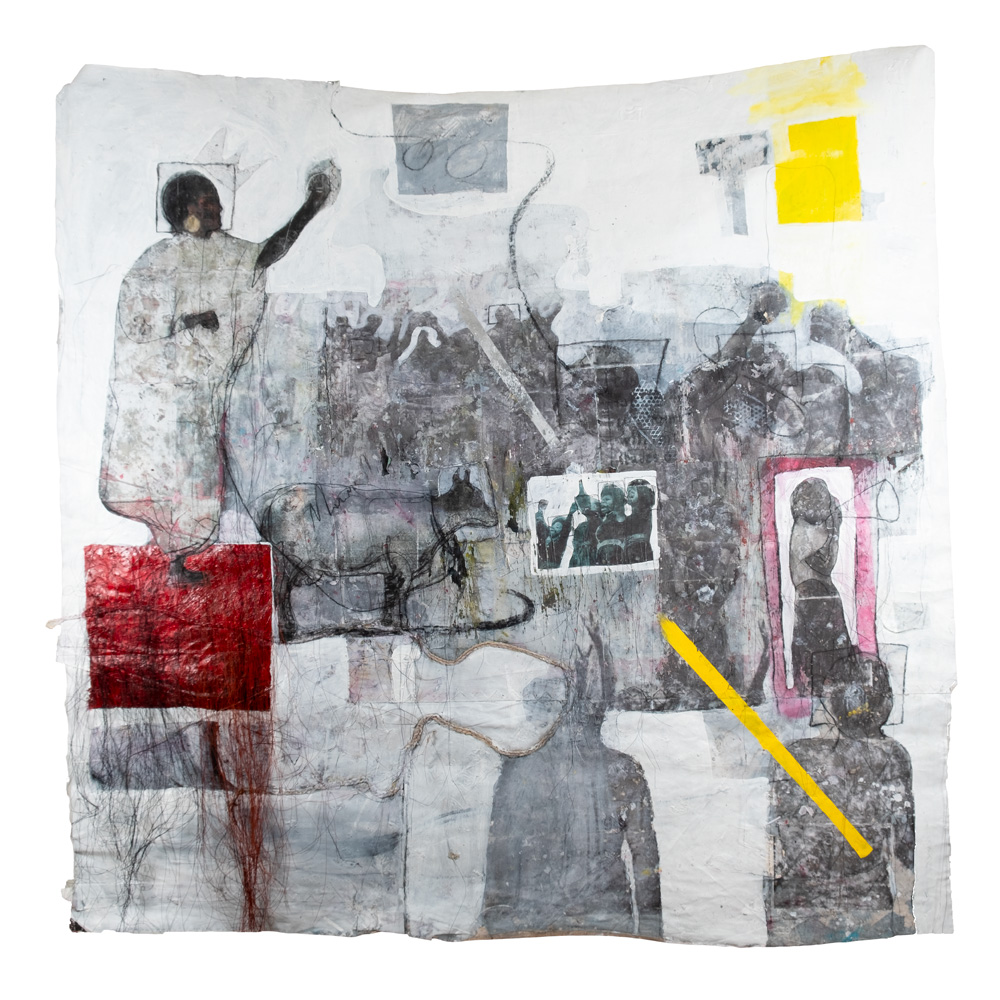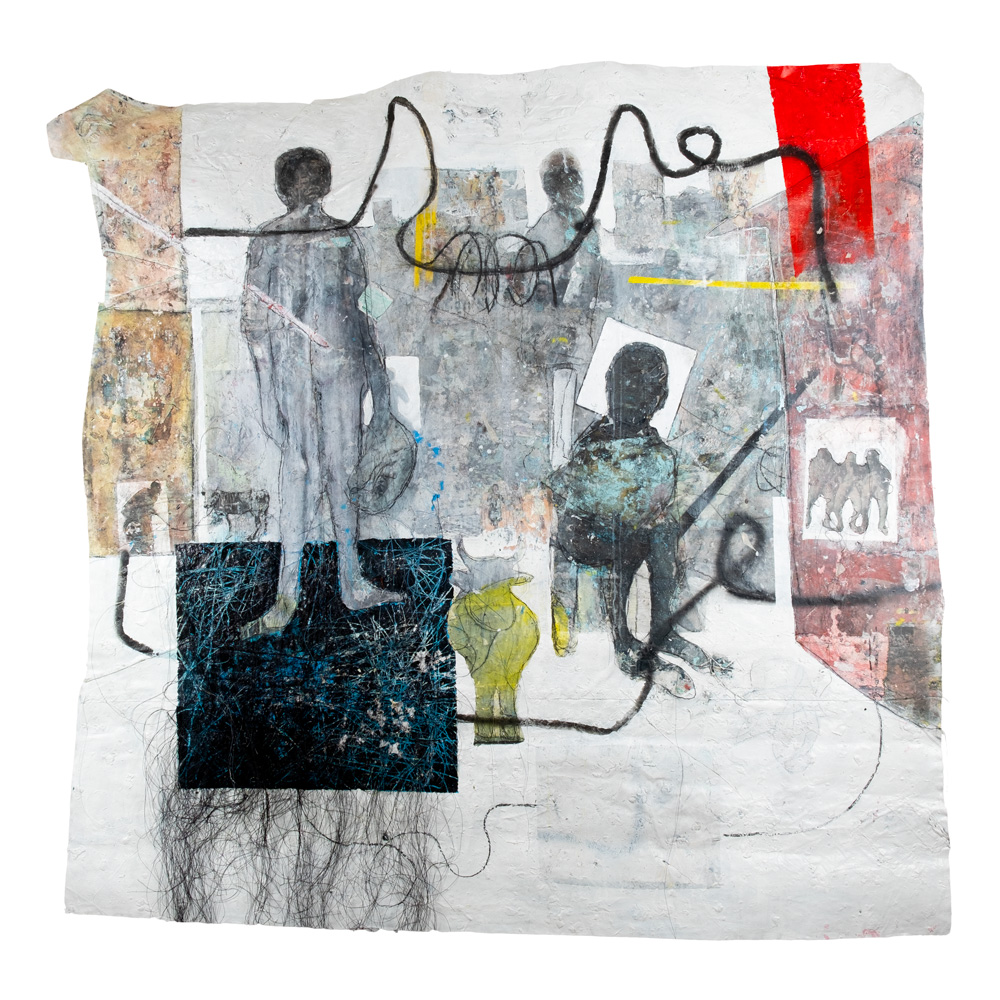KALOKI NYAMAI

What I Won't Tell You
SEPTIEME Gallery, Paris
Curated by Salimata Diop
October 26 – November 23, 2019
History is a multitude of interlaced threads. When memory and truth are lost in a tapestry of lies and revisions, a single thread suffices for them to be found. While the historian takes a step back to see the canvas, the artist takes a step forward to caress the thread. Through his work, he offers a space of emotional resonance to the truth that hangs by a thread. Without saying a word, he heals the wounds left by History. Today, Kaloki Nyamai will not speak to you of his mother, nor of his people, nor of his country. He will not speak to you of a history rewritten by the vanquishers, nor of a culture they attempted to annihilate, nor of a language that replaced that of his ancestors. The artist presents us with works marked by distant and contemporary stories, characters and memory. Beyond their complexity, their nuances, and beyond the way in which layers of canvas, paint, paper and charcoal are juxtaposed and superimposed, emanates a singular and powerful truth.
The Hero is a Woman
In the Kamba language, Gewa, kana ka musyemi koo vala kae means the hunter’s daughter is where he is.
The ensemble of six works speaks to us of a strength that it is not always in good form to celebrate in this era: that of women. The artist asks us: isn’t strength fundamentally feminine? He gives us no other response than his work that, in a multitude of brush strokes, collages and charcoal outlines, gives us intuitive proof, a singular truth.
Today, the artist will not speak to you of his mother. If his personal journey, his mourning process, inspired an earlier series, this new corpus is destined for us: a tribute, to the mother, to the woman, in the name of each and every one of us.
The hunter’s daughter is where he is: that she isn’t seen and that her very existence can be omitted has no hold on the truth. For this woman, on whom so many responsibilities rest, does indeed exist, powerfully. Even in the shadows. She will not seek her reflection in vain in the eyes of others, or even in an amnesiac story. The same is true for the mother who knows what she has accomplished in a world where the archetype of the hero and strength are inexorably granted to the masculine.
Kaloki Nyamai’s works actually come from far beyond his Nairobi studio. In Ethiopia, the artist asks: tell me about your heroines, tell me about your warrior women, tell me about your queens, tell me about your mothers. In Haiti, he does the same. And in Benin. In Tanzania. Everywhere, he finds only silence, half-effaced, relegated, amputated stories: we hesitate, we stammer, at most, we make mention of.
What history has chosen to forget is nevertheless a truth that patiently waits for us to free it, to tear it off or to glean it. This forgotten thread of the tapestry – a distant echo of a local legend or a conversation with the ancestor – waits tirelessly to be delicately picked up, gently transplanted, finally. One thread at a time, through the artist’s sure and precise gesture, the tapestry, sometimes distorted and vandalized by the stakes of power and time, is reprised. Healing. The truth is singular, it is also surprisingly resilient.
Transparencies
Each of Kaloki Nyamai’s works is born of the heavy choice to set his creative process. Countless times, the work comes to life before finally returning to the status of backdrop. The choice of the final gesture is almost aberrant, almost absurd, because it is always possible to continue to make the visible invisible, to transform what is clearly states into a barely perceptible echo.
The beginning is the canvas, soon completely covered with black, then grey. Then come other layers: they follow one another, automatically altered by the previous layer. Thus, Kaloki Nyamai’s white is never white, and always different.
As for the limitation of the format of the canvas, it is itself transgressed – cut, sewn, nothing guarantees a square or rectangular format – from the medium to the colors and the shape of the canvas, the artist liberates himself of all borders.
The process of painting and recomposing the canvas is only the first chapter in the genesis of the work. Now you have to imagine the artist busy disposing of the hundreds of black and white photographs printed on paper on the floor of his studio. These are the characters of the story he is about to create, and he chooses them carefully without leaving anything to chance. The silhouettes that populate Kaloki’s painting are never fictional: their history and provenance make them the guardians of a reality, whether it is a naked and chained slave or a child pushing a tire through a sandy street. The artist sticks these photographs on his canvases in such a way that the ink is transferred to the work. Some of these silhouettes are destined to fade under a layer of paint, others to remain at the forefront of the scene; others will disappear completely. However, even if they are invisible, they will have fulfilled their role in the construction of the history carried by the work.
The materials the artist uses are immensely varied: sisal, cables, wires, earth… here again all limits are removed and the freedom to innovate is total. This brings a unique texture and relief to his works: they can only be meaningfully explored in three dimension. The rules of the game are set, the visitor whose eyes are drawn to a work will have no choice but to constantly move around the canvas to explore it. An approach rewarded with a thousand discoveries. A charcoal silhouette or outline can be revealed at any time. A work is to be discovered and rediscovered indefinitely.
This is the essence of the artistic technique developed by Kaloki Nyamai: add, remove, add, scratch, add again, subtract… The final visual result is in no way predestined, in the sense that the genesis of the work is organic. What matters is not the point of arrival, but the path: History.
– Salimata Diop




